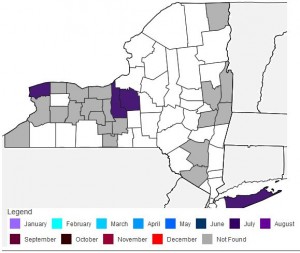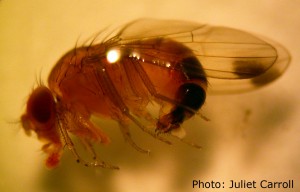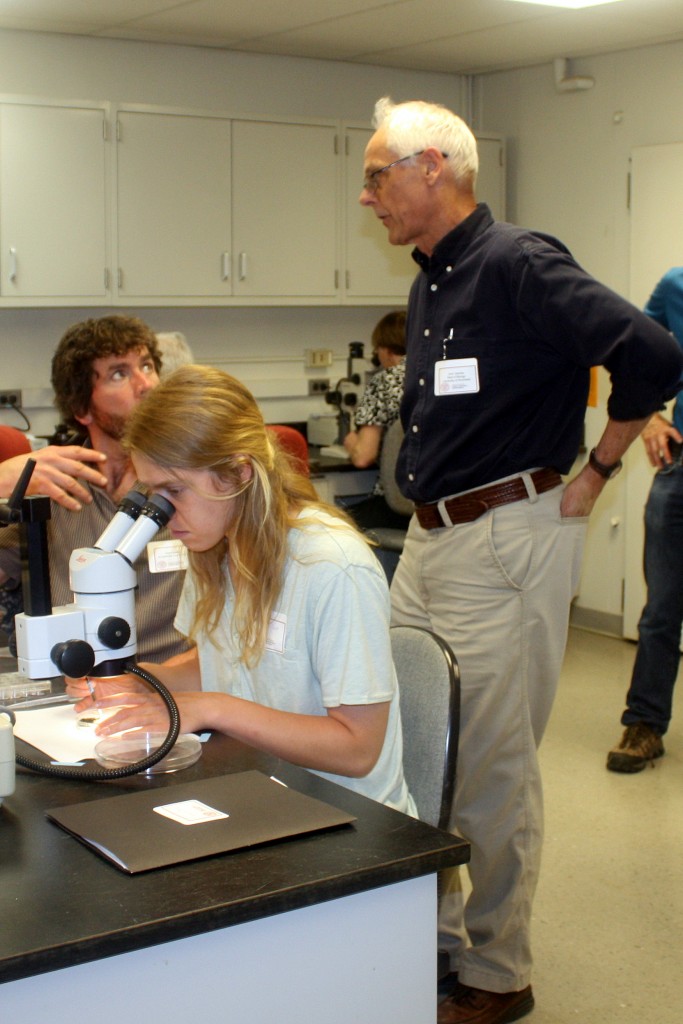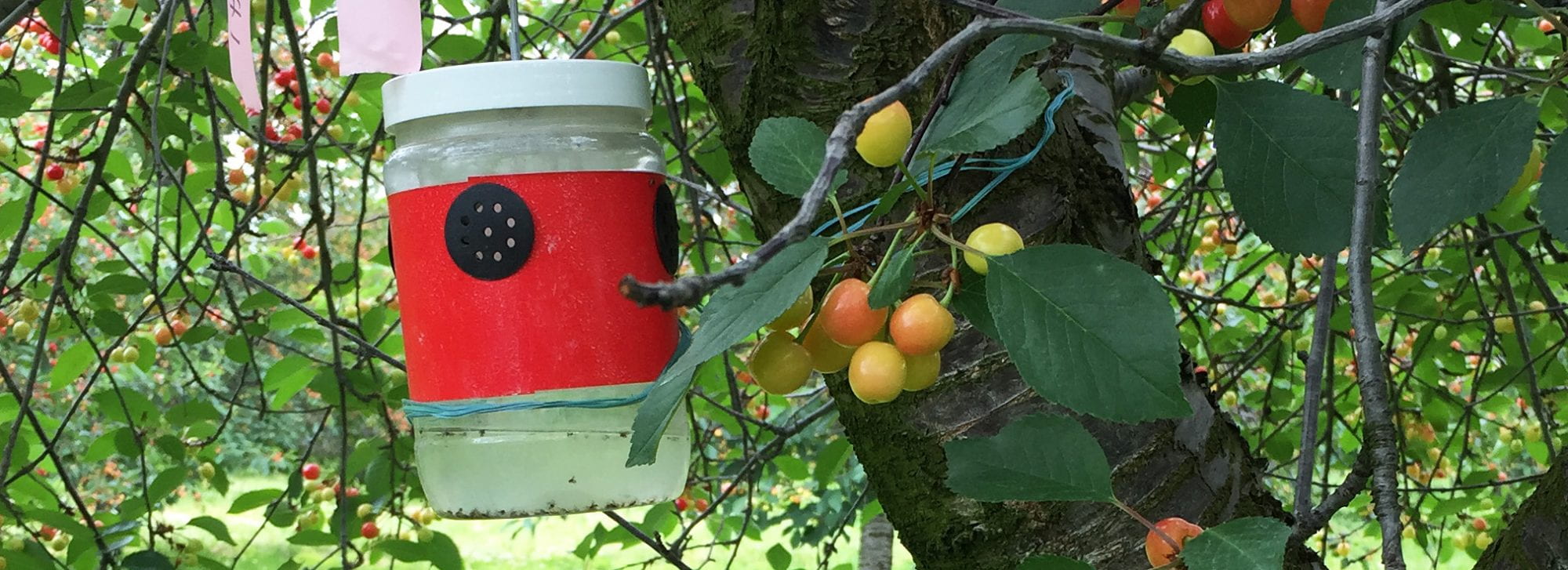SWD adults have been caught at two locations in Ontario County this week ending July 17, 2014, five at one location and three at the other. All traps were the apple cider vinegar and fermenting dough cup trap and are monitored by Gabrielle Brind'Amour in Greg Loeb's program, Dept of Entomology, Cornell University, Geneva, NY. At one location, three females, one per trap, were caught in a summer raspberry planting; one of the traps was on the edge of the planting and the other two were within the crop. At that same location, one male and one female were caught in a trap placed in the nearby woods. At the second Ontario County location, one male and one female were caught in a trap on the edge of a blueberry planting, as well as a single male in a trap at the woods' edge facing the blueberry planting. (GDD 1235, day length 14:55)
Category: 2014 trap network
Schuyler County – first find
A single male and a single female were found on July 16, 2014 in yeast baited apple cider vinegar traps in Schuyler County by Gabrielle (Gabe) Brind'Amour in Greg Loeb’s program, Dept of Entomology, Cornell University, Geneva, NY. The male was in a trap set in the wooded edge of a blueberry planting and the female was in a trap on the edge of a summer raspberry planting. (GDD 1305, day length 14:54)
Because the population of SWD is still at very low levels in NY, take time to review available insecticides and plan a program for at-risk fruit that is beginning to ripen. Berry insecticide tables and tree fruit and grape insecticide tables are found on Cornell Fruit Resources.
Seneca County – first find
A single male SWD was caught on July 16, 2014 in a yeast baited apple cider vinegar trap set in a blueberry planting in Seneca County by Gabrielle (Gabe) Brind'Amour in Greg Loeb's program, Dept of Entomology, Cornell University, Geneva, NY. The population of SWD is still at very low levels in NY, providing an opportunity for growers to practice sanitation or clean-picking of fruit that is nearing the end of the harvest period. This early alert provides an opportunity to review available insecticides and plan a program for at-risk fruit that is beginning to ripen. (GDD 1270, day length 14:55)
All positive finds reported to date have been single individuals caught in single traps. There are two to four traps set at each monitoring location. Cornell Cooperative Extension has set 192 traps at 52 sites in New York. Traps are checked weekly.
Niagara County – first find
A single female was caught on July 15, 2014 at each of two locations in Niagara County. One location is a raspberry planting and the other is a blueberry planting. Two yeast baited solo cup traps were set at both locations by Liz Tee in Deborah Breth's Lake Ontario Fruit Program, Cornell Cooperative Extension. Fruit is ripe and ripening. An up-to-date distribution map for NY and the Eastern US can be found on the Cornell Fruit Resources SWD Distribution page, courtesy of the Southern Region IPM Center and the University of Georgia Center for Invasive Species and Ecosystems Health. (raspberry site GDD 1120; day length 15:00) (blueberry site GDD 1023; day length 15:01)

Cayuga County – first find
A single female SWD was caught in one of four yeast-baited apple cider vinegar traps checked on July 8, 2014 and set in a summer raspberry planting in Cayuga County by Juliet Carroll, NYS IPM Program. Fruit is ripe and nearing the end of harvest. Because at this time the SWD population is very low, if no other susceptible fruit is nearby and ripe, it may prove judicious to hold off on an insecticide management program. Consider creative approaches to sanitation in U-pick plantings such as providing a discount on purchased fruit when the customer brings in an extra bucket of damaged and over-ripe fruit to the counter. Keep track of fruit ripening in other berry crops and plan to protect these with insecticides in the coming weeks. (Accumulated GDD 1124; day length 15:05)

Onondaga County – first find
A single male SWD was caught in one of four yeast-baited apple cider vinegar traps checked on July 8, 2014 and set in a summer raspberry planting, variety Prelude, in Onondaga County by Juliet Carroll, NYS IPM Program. Fruit is ripe and being harvested. At this time the SWD population is very low and although cultural practices such as harvesting fruits frequently and removing rotten fruits from the field will help keep the SWD population down, if susceptible fruit is nearby and ripening, it may prove judicious to consider planning for and beginning an insecticide management program. SWD populations and damage can increase dramatically with favorable weather and susceptible ripe fruits. The weather in central NY has been cool at night with daytime temperatures in the upper 70's and low 80's. Insecticide applications are necessary when SWD populations are high. Insecticides labeled for use in commercial berry production are tabulated on the Cornell Fruit Resources' SWD website. (Accumulated GDD 1169; day length 15:09)

First find in NY – Suffolk Co.
The first two female SWD of the 2014 growing season were captured over the week of July 3 to 9 in traps monitored by Faruque Zaman, Long Island Horticultural Research and Extension Center, Suffolk County Cornell Cooperative Extension in a yeast-baited trap at a ripening raspberry location in eastern Long Island.
On July 9, examination of 40 fruits found 2 SWD-infested raspberries with egg-laying sites at that location. The raspberry field is surrounded by grapes on one side and blackberries on the other side; no adjacent forest boundaries. No SWD have been captured in traps placed in other locations in Suffolk County, including blueberry, blackberry, grape, forest and a second raspberry site and no fruit infestation was found in raspberries collected from the second site.
At this time the SWD population appears to be very low. Therefore, cultural practices such as harvesting fruits frequently and removing rotten fruits from the field will help keep the SWD population down. Also, remove alternate weed hosts, pokeweed and bittersweet nightshade, from the area before these weeds develop fruit. SWD populations and damage can increase dramatically with favorable weather and susceptible ripe fruits. Insecticide applications are necessary when SWD populations are high. Insecticide control requires frequent applications (5-7 day interval), so delay onset of spraying until sustained captures occur in your area to maximize the utility of the applied materials.


Monitoring in NY
SWD traps are being set out across NY in berry plantings by Cornell Cooperative Extension (CCE) personnel for the 2014 monitoring season. Trap catch results from the following counties will be reporting to the NY distribution map: Albany, Cayuga, Chautauqua, Chemung, Clinton, Columbia, Dutchess, Erie, Herkimer, Livingston, Monroe, Niagara, Onondaga, Ontario, Orange, Orleans, Rensselaer, Saratoga, Schuyler, Seneca, St. Lawrence, Steuben, Suffolk, Tompkins, Ulster, Washington, Wayne, Wyoming, and Yates.
Statewide monitoring wouldn't be possible without the cooperation of all involved: Ginny Carlberg and Betsy Burgeson, Chautauqua County CCE; Jabe Warren, Chemung County CCE; Amy Ivy and Lindsey Pashow, Clinton County CCE; Sharon Bachman, Erie County CCE; Bernie Armata, Herkimer County CCE; Dave Thorp, Livingston County CCE; Paul Hetzler, St. Lawrence County CCE; Stephanie Mehlenbacher, Steuben County CCE; Faruque Zaman, Suffolk County CCE; Emily Cook, Ulster County CCE; Don Gasiewicz, Wyoming County CCE; Laura McDermott, Cara Fraver, Jim O'Connell, and Dan Donohue, Eastern NY Horticulture Program; Deborah Breth and Liz Tee, Lake Ontario Fruit Program; Peter Jentsch and Tim Lampasona, Entomology, Hudson Valley Lab; Greg Loeb and his lab group, Entomology, NYS Ag Experiment Station; and Juliet Carroll, NYS IPM Program, CCE.
Many of us participated in a SWD Workshop, held in May 2014, to hone our skills at identifying these tiny, destructive fruit flies. On hand to teach us the finer points of identifying female and male SWD and many other fruit fly look-alikes were Greg Loeb, Professor of Entomology, and members of his lab, Steve Hesler, Anna Wallingford, and Johanna Elsensohn, and John Jaenike, Professor of Biology and Drosophila expert, University of Rochester.


